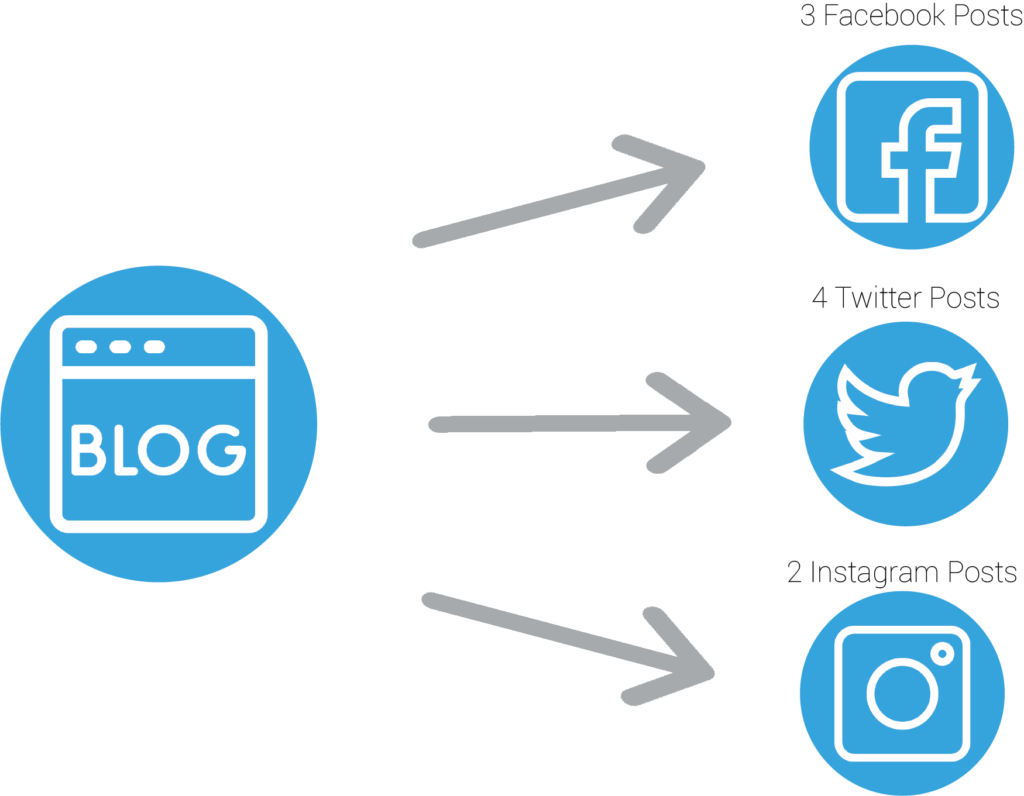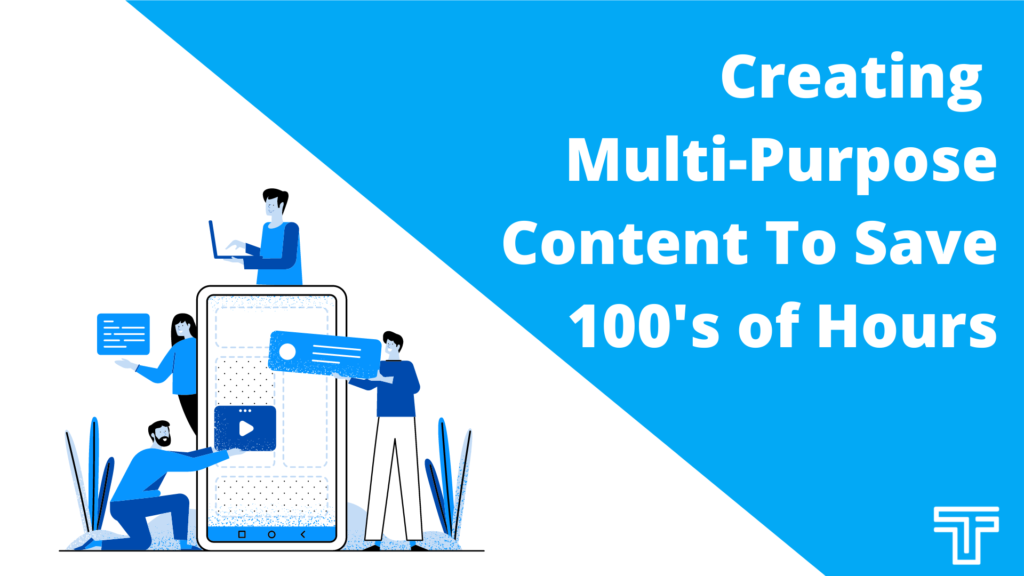What is Content Marketing
Content marketing is a form of marketing that involves sharing material and messaging such as videos, blogs, articles, reports, etc. Sharing free content in order to attract prospects and convert them into customers.
Content should not simply be written for the sake of creating content, you need to find your why. The concept coined as ‘the golden circle’ by Simon Sinek is incredibly successful in generating buy-in for an organization and helps companies understand their why for content. In summary, Sinek says that companies often focus on marketing from the outside of the circle inwards i.e what, how, why. Instead companies should be focusing on marketing from the inside out i.e. why, how, what. By starting with the why, customers are interested from the beginning. In Sinek’s words “people don’t buy what you do; people buy why you do it”.
Two Concepts for Multi-Purpose:
There are two concepts that relate to what is commonly referred to as multi-purpose content.
- Multi-Purpose Content (aka. Parent -> Child)
- Planning based
- Shelf Life / Recycling
- Follow Up Based
Multi-Purpose Content (Parent-Child)
Multi-purpose content is what most people think of when they consider using the same content for multiple platforms or uses. This structure can be pre-planned as it’s easy to break up and scatter through the months.
For example, you sit down and decide that you want to write a blog post. You can take key facts from that blog and turn them into 3 Facebook posts, 2 LinkedIn posts and 4 Twitter posts. You can then schedule it across an entire month or multiple months. Then fill in the gaps with other types of content. This way you go from having to plan and writing multiple posts to only really thinking about one or two truly unique posts. In the customer’s eyes it all appears fresh and new but you’ve saved yourself hours of creation and brainstorming time.
Another type of multi-purpose content could be testimonials. Testimonials are usually found on your website or Google My Business page (if you have one, which we highly recommend you do). Upon collecting a few testimonials, your brand now has the ability to place them on your website as well as create a recurring social media series where you highlight a customer’s opinion on your product or service. Add in a nicely designed repeatable image to accompany each post and you’re off to the races!

The Shelf Life
The second concept is the shelf life that applies to content. You might not know it but just like food, content has a shelf life and each platform has a different associated timeline.
| Platform | Shelf Life |
| Typically expect it to last for 5 hours in which the post receives about three quarters of its total engagements. | |
| The average content lifespan is 48 hours in which the post received 75% of their total comments. | |
| Similar to Instagram Linkedin post has an average lifespan of 48 hours but can pick momentum up later on based on LinkedIn’s feed algorithm | |
| Twitter is constantly pushing content. A tweet’s lifespan is an average of 18 minutes | |
| In-house Blogs | Blogs are examples of an item that has a long shelf life. The average lifespan of a blog is one to two years |
Another thing to note is that people are forgetful, particularly on the platforms with a short shelf life. An average person won’t recognize the same content if different wording and images are used.
Another key aspect of this concept is that if a certain type of content worked really well and got a lot of engagement. Don’t be afraid to follow the same template and post something similar.
Which Content Should I Repurpose?
There are two things to consider when you’re deciding which content to repurpose.
Understand The Life of Each Activity
It’s important to understand how long each post lives for. This gives you a better idea of how many more times you can post it and when it’s time to start thinking about other ideas and concepts. So if an instagram post has a shelf life of 48 hours you could get away with repurposing that content another few times the next month and the month after that.
Use the Data From Both Blog and Social Media
Look at data available to you from your social media, website and any external sources such as Google Analytics. Then based on these factors you can determine which posts are deemed successful and not successful. Visit your google analytics account and check your most recent post that perhaps got 200 visitors vs a post that got 10 visitors you can do an audit and figure out why that post was so much more successful. Did you include a picture? If so, what type of picture was it? What kind of tone did you use for your messaging? What type of content was it? Funny? Informative? Etc. Once you determine that, you can use that same format for another post.
How to Recycle/Spin Content In Different Ways
Now that you know which posts were successful you can now start the process of recycling/spinning the content in different ways. There are different ways to do this but let’s take an example of using a blog post and breaking it down into different content pieces.
1. Select parent content
First step is to select the ‘parent’ content i.e. the blog post that you want to break down into more posts.
2. Highlight key pieces of information
You’ll want to go through the parent post and determine 2 -3 key pieces of information that you want to highlight and eventually post on your social media.
3. Plan out when you will post each piece of content
Once you know what information you want to post you want to plan out when you are going to post them. Make sure you spread them out and fill in the gaps with other content.
4. Deciding how you will change it
You’ll then decide how you will change the content. You can change the wording/messaging keeping in mind the tone of your text. For example, if you took a more serious tone originally maybe think about taking a more laid back and relaxed approach. Another thing to consider is determining if you wanted to create some sort of infographic or visual for the post. This is a great opportunity to display the valuable message in a new appealing format.
5. Create and post
Actually create the post(s) and share them out when scheduled.
If you’re still not convinced about multi-use content, check out the experiment Buffer conducted. Buffer is a social media software company that allows organizations to manage their social media accounts from one place.
The Buffer team rolled out a brief experiment in 2015 to see what would happen if they stopped producing new content and only repurposed/refreshed their existing content. This strategy involved repurposing two to three new pieces each week for one month. At the end of the experiment, organic search traffic grew over 4%. New SlideShare presentations nabbed almost 200,000 views, and one Medium post captured 2,888 views and made it into the Top 20 for a day. This just goes to show that the power of repurposing is incredible and you don’t need to spend hours upon hours trying to think of new content.

Building A Content Creation Framework
A critical aspect of ensuring you are repurposing your content is making sure you have an efficient content creation framework. Without it nothing can happen. This is a breakdown of what an optimal framework could look like for you:

1. Brainstorm new ideas
A basic step. You want to get the creative juices flowing and spend some time figuring out what content you want to put out. You also want to make sure that you’re creating content for each stage of the buyer journey i.e. awareness, consideration, decision, and retention. If you get stuck, think about what your customers ask you frequently.
2. Planning timeline
Use your goals to determine what content you need to focus on. For example, if your goal for the quarter is to increase leads then plan out 2-3 content offers in exchange for emails that you can write about.
3. Create a workflow
You also want to create a workflow. You want to lay out the journey that the piece of content will go through from beginning to end. Identify who will do what and be specific. For example, person A is responsible for writing the blog, person B is responsible for reviewing and making edits, person C is responsible for SEO optimization, and person D is responsible for creating micro-content from it.
4. Review and edit content
Of course before you post anything you want to make sure that you review and edit all your content for any grammar mistakes. You also want to make sure that you are optimizing your post for search engines. You can also use a style guide in order to have consistency with your blogs and posts. Again with this step you want to make sure you are establishing a consistent workflow. Set clear expectations for due dates, guidelines on how to track changes and define the roles for the reviewal process.
5. Organize and store content
The final step is having a centralized location and naming system to store all your content. You also want to make sure you have a clear naming convention in order to keep everything organized. For example, date posted.content type.title. So it would look something like this 05.17.2021-blog-beginner-business-analytics
How Can Tactycs Help
If you didn’t already know Tactycs also functions as an extension of your marketing team. Combined with our marketing software we can help you develop your content. Depending on how in depth you would like our involvement, we are able to take on the entire content creation process; planning, writing, editing and posting. Or we can help with editing, reviewing and SEO optimization. You get to choose how involved we are as an additional arm of your team.
